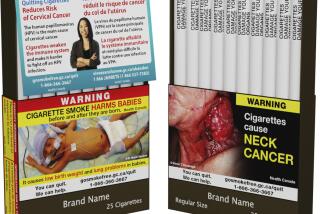FDA Begins Drive to Redesign Drug Labels : Regulation: Officials say the goal is to make over-the-counter product information clearer. New nutritional markers will be the model.
- Share via
WASHINGTON — The Food and Drug Administration has begun overhauling the labels on over-the-counter drugs to make information more readable and understandable for consumers, agency officials said Friday.
The redesigned labels, which would appear on medicines purchased without a physician’s prescription--such as aspirin and antacids--likely will be modeled after the new nutritional labels that are now on food packages across the nation. The new food labels feature a standard, easy-to-read format that is consistent among all products.
“Our goal is to have better-informed consumers,” said Dr. Michael Weintraub, director of the FDA’s office of over-the-counter drug evaluation, who presented the plan at a meeting of a joint subcommittee of the agency’s non-prescription drugs and arthritis advisory committees.
“We want people to be able to pick up a box of medication and know (from the label information) whether it’s for them,” he added.
Nevertheless, agency officials emphasized that the work toward revamping the labels had only just begun and that there are numerous obstacles to overcome.
One of the biggest problems--and the most frequent complaint of consumers--is tiny print size, which is very difficult to read for many consumers, particularly the elderly, they said. It results from manufacturers having to include all required information on a small package, they said.
“Print size is a problem, and getting this information to consumers is a problem,” said William E. Gilbertson, director of the FDA’s monograph review staff. “We have to consider ways to improve upon this. Right now there is no (FDA) regulation regarding print size.”
Industry officials pledged to cooperate and work with the FDA to develop the new labels.
“The goal for better readability is one we all have,” said R. William Soller, senior vice president and director of science and technology for the Non-Prescription Drug Manufacturers Assn. “The general feeling within the industry is that there are ways to make the label better. . . . We are committed to good label readability.”
The FDA said it is considering changes in text and format, including increased print size, and the possible use of boxed areas, symbols and contrasts in colors to emphasize warnings and other information.
In 1990, California approved legislation asking manufacturers of over-the-counter drugs to voluntarily make their labels more readable but some have complained that the law has no teeth because the changes are not mandatory.
The agency is expected to study and test numerous draft labels among focus groups and others before releasing its proposals.
Typically, such proposed regulations are then subject to a period of public comment before final rules are released. Also, the industry likely would be given a time frame to use up old labels and phase in new ones. Thus, it could be several years before new labels actually begin appearing on products.
The FDA first proposed revamping food labels in 1989. A year later, as the agency prepared to issue its final regulations, Congress approved legislation that, among other things, established an explicit timetable to implement the new labels, thus speeding up the process. The first new food labels began appearing in the summer of 1993. Last May was the final deadline for most foods.
The FDA does not need congressional legislation to effect such changes on those products under its jurisdiction, although Congress has the power to overrule or alter the FDA’s authority.
More to Read
Sign up for Essential California
The most important California stories and recommendations in your inbox every morning.
You may occasionally receive promotional content from the Los Angeles Times.













